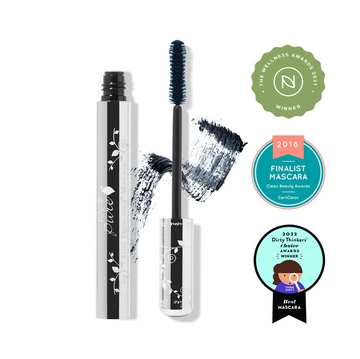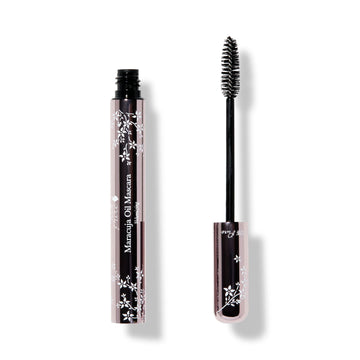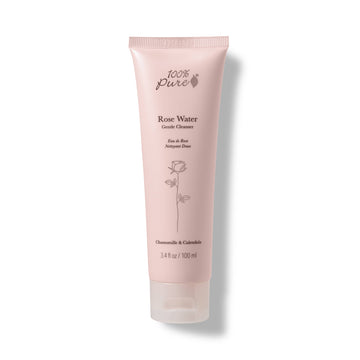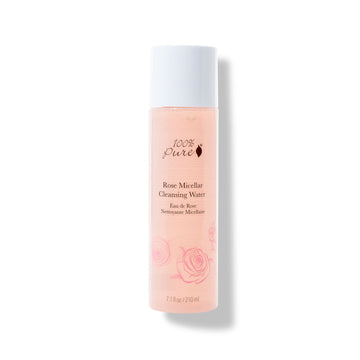Protect Your Natural Lashes with These Gentle, Effective Techniques
Posted on April 22, 2025 Written by: 100% PURE®
Mascara is a beauty essential that instantly defines and lifts the eyes—but removing it the wrong way can do more harm than good. Tugging, scrubbing, or skipping proper cleansing can lead to lash breakage, thinning, or even fallout over time.
To help you keep your lashes long, strong, and healthy, this guide breaks down the safest, most effective ways to remove all types of mascara, including stubborn waterproof and tubing formulas. We’ll also highlight the most popular lash-loving products from 100% PURE that cleanse gently while nourishing the delicate eye area. Let’s protect your lashes while keeping your makeup routine clean.

Understanding Mascara Types and Their Removal Needs
Mascara isn’t one-size-fits-all, and neither is the way you remove it. Different formulas cling to your lashes in unique ways, so it’s important to match your remover to your mascara type to avoid breakage or lash loss.
Traditional Mascara
Traditional mascara is water-based and the easiest to remove. It typically contains natural waxes and pigments, and it washes off easily with warm water and a gentle cleanser—perfect for everyday use and sensitive eyes.
Waterproof Mascara
Waterproof mascara is designed for long-lasting wear, even through tears or sweat. This type contains waxes and silicones, which create a strong, water-resistant hold. However, this also means it needs an oil-based remover to fully break down the formula without tugging at delicate lashes.
Tubing Mascara
Tubing mascara offers a unique application—it wraps around each lash in tiny, flexible tubes. It won’t smudge or flake, and it comes off with just warm water and a bit of gentle pressure. This makes it an ideal choice for those with sensitive eyes or anyone who dislikes harsh makeup removers.
Long-wear Mascara
Long-wear mascara is a hybrid formula that blends durability with easier wearability. These mascaras use film-forming agents to stay put all day but may not come off with just water. For effective removal, a bi-phase makeup remover or a cleansing balm is usually best to dissolve the layers without irritating the eye area.
Recommended Products:
100% PURE Fruit Pigmented® Ultra Lengthening Mascara– A clean, plant-pigmented formula that lengthens and defines lashes while conditioning them with lash-friendly ingredients.
100% PURE Maracuja Mascara– A long-lasting yet gentle option that nourishes lashes with maracuja oil, making it perfect for sensitive eyes and everyday use.
Why Improper Removal Damages Your Lashes
Taking off mascara the wrong way can do more than cause irritation—it can lead to lasting lash damage. Your lashes are delicate, and how you remove makeup affects their strength and health.
Rubbing, tugging, or pulling puts mechanical stress on lashes, causing them to snap or fall out early. Even brief rough handling can weaken the lash line over time.
Harsh removers with alcohols or synthetic ingredients strip natural oils, drying out lashes and weakening their structure. Leftover product can block follicles and stunt growth.
Improper removal also disrupts the natural lash cycle. Damage at the root can delay regrowth and lead to thinning or sparse patches.
To keep lashes healthy and full, be gentle, use the right remover, and nourish them during the process.
The Best Mascara Removal Methods
Proper removal isn’t just about getting rid of makeup—it’s a crucial step in protecting the health of your lashes. Here are the most effective methods for taking off mascara gently and thoroughly, no matter what type you’re wearing.
Method 1: Soak and Sweep
Saturate a soft cotton pad with micellar water or a cleansing balm. Gently press it against your closed eye for 20–30 seconds to dissolve the product. Then, sweep downward in the direction of your lashes—never rub side to side.
Best For: Waterproof, long-wear, and traditional mascaras.
Method 2: Warm Compress
Soak a washcloth in warm (not hot) water and press it lightly over your closed eyes for about 30 seconds. This loosens the mascara’s hold—especially tubing or water-soluble types—allowing it to wipe away with minimal effort.
Best For: Tubing mascaras and traditional formulas.
Method 3: Double Cleanse
Start by massaging an oil-based balm into your lashes to break down stubborn product. Follow with a gentle water-based cleanser to remove residue and soothe the skin. This method ensures a clean finish without over-stripping.
Try:
100% PURE Blood Orange Cleansing Balm - A rich, citrus-infused balm that melts away makeup while nourishing skin with antioxidants.
100% PURE Rose Water Gentle Cleanser - A soothing, hydrating cleanser that gently lifts impurities using calming rose water.
Method 4: Precision with Q-tip
For stubborn residue near the lash line, dip a cotton swab in micellar water or oil remover and gently roll it along the roots of your lashes. This allows for targeted cleanup without excessive rubbing.
Best For: Detail work and sensitive lash lines.
Using these gentle techniques will help preserve your lashes, reduce fallout, and keep the delicate eye area soothed and nourished.

Best Products for Gentle Mascara Removal
The key to healthy, beautiful lashes starts with how you remove your mascara. Harsh scrubbing or drying formulas can do real damage over time. Instead, opt for oil-based cleansers that both nourish and effectively dissolve even waterproof makeup. Look for ingredients like jojoba oil, which mimics your skin’s natural sebum and helps protect the delicate lash line.
For lighter wear or sensitive eyes, micellar water is a must-have. It gently lifts away pigment without irritation or stinging.
Try: 100% PURE Rose Micellar Cleansing Water– ultra-soothing and perfect for daily use.
Nightly Mascara Removal Routine
A good removal routine keeps your lashes intact and your eye area calm.
- Start by washing your hands to avoid transferring bacteria.
- Next, saturate a cotton pad(never use it dry), and gently press it against your closed eye for 20–30 seconds. This gives the formula time to dissolve.
- Wipe downward only—avoid aggressive back-and-forth motions.
- Always use a fresh pad per eye to reduce the risk of irritation or infection.
- Follow with a gentle facial cleanser, then pat dry(don’t rub) with a soft towel.
Some mascaras need a little extra attention. If pigment remains after your first swipe, repeat with a new pad or switch to a stronger remover like a cleansing balm or bi-phase formula. The most important rule: never pull or scrub aggressively—your lashes will thank you.
Special Tips for Different Lash Needs
Lash Extensions: Avoid oil-based removers and cotton pads, which can damage adhesive or tangle around extensions. Use a water-based, lash-safe remover and gently brush through with a clean spoolie.
Sensitive Eyes: Choose formulas that are fragrance-free and preservative-free. Always patch-test new products before applying them to the entire eye area.
Damaged or Shedding Lashes: Use a lash serum that contains peptides, biotin, or panthenol to promote regrowth. Try limiting mascara use on fragile days and let your lashes breathe.
Post-Removal Lash Care
After cleansing, show your lashes some love. Apply a conditioning oil like castor or jojoba to nourish and strengthen them overnight. Take mascara breaks once or twice a week to avoid over-stressing your lash line. Use a clean spoolie to brush lashes gently, which also helps distribute natural oils. And don’t forget—hydration and a nutrient-rich diet go a long way in supporting lash and overall hair health.
Treat Your Lashes With Love & Care
Proper mascara removal protects your lashes just as much as good application enhances them. Skip the harsh rubbing—choose gentle, soak-based methods instead. Nourish your lashes with hydrating, natural products like those from 100% PURE. With daily care, you’ll keep your lashes healthy, strong, and beautifully mascara-ready.
Frequently Asked Questions (FAQs)
1. What is the safest way to take off waterproof mascara?
The safest way to remove waterproof mascara is by using an oil-based remover a bi-phase cleanser. These products break down the waxes and silicones in waterproof formulas without causing damage to your lashes. Gently press a soaked cotton pad against your closed eyes for 20–30 seconds before wiping downward.
2. Can I use coconut or jojoba oil to remove mascara?
Yes, both coconut oil and jojoba oil are effective and gentle for removing mascara. They naturally dissolve makeup while also nourishing your lashes. Simply warm a small amount between your fingers, apply it to your lashes, and gently wipe away with a cotton pad.
3. How do I remove mascara without losing lashes?
To avoid lash loss, be gentle. Use soft cotton pads or microfiber cloths, and don’t rub or tug. Saturate your remover, press gently against your lashes, and wipe in the direction of hair growth. Always use fresh pads to avoid friction or irritation.
4. Why is my mascara so hard to remove even with cleanser?
If your mascara is hard to remove, it may be because it’s waterproof or a long-wear formula. These products contain stronger ingredients that resist breaking down. You may need a stronger remover, like an oil-based cleanser or a bi-phase product, to dissolve these formulas completely.
5. How often should I clean my lashes after wearing mascara?
It’s important to clean your lashes every night after wearing mascara. This removes buildup and prevents clogged follicles, which can lead to irritation or lash loss. Regular cleaning also keeps your lashes healthy and your eyes free of bacteria.
- Tags: April-2025
We carefully hand-select products based on strict purity standards, and only recommend products we feel meet this criteria. 100% PURE™ may earn a small commission for products purchased through affiliate links.
The information in this article is for educational use, and not intended to substitute professional medical advice, diagnosis, or treatment and should not be used as such.
















